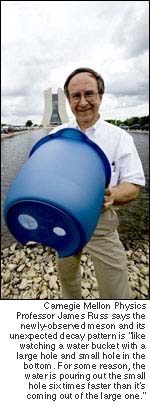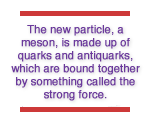|
|
||||
|
|
Carnegie Mellon Physicist Leads Discovery of Puzzling New Particle
The new particle, a meson, is a particle made up of quarks and antiquarks, which are bound together by something called the strong force.
The heaviest member ever observed in the meson family, this new particle behaves in surprising ways. It decays about five times more often than expected into an eta particle (a rarer but experimentally well-studied member of the meson family) than it does into the expected state, called a K meson.
"It's like watching a water bucket with a large hole and small hole in the bottom," said James Russ, professor of physics at Carnegie Mellon and spokesman of the SELEX (Segmented Large X baryon Spectrometer) experiment. "For some reason, the water is pouring out the small hole six times faster than it's coming out of the large one. Something unusual must be going on inside the bucket."
The new meson also decays more slowly than expected for its size. Mesons tend to be a short-lived tribe. The more massive the particle, the shorter the lifetime of its state should be. Not this time.
But SELEX did see it, and the observation expands our picture of the ways in which the strong force controls interactions within the atomic nucleus. The strong force keeps the nuclei of atoms from flying apart, and it controls the decay rates of particles. This newly observed meson raises the questions of why it breaks the highly predictable decay pattern of mesons, and of how many other patterns there might be.
"Strong decays follow the rule that the heavier the state, the faster it falls apart, all other things being equal," said Russ. "It's that last part — all other things being equal — that makes the new state so interesting. Now we have to learn what conditions are un-equal."
The discovery by the members of the SELEX collaboration uses data from their experiment at Fermilab's Tevatron, the world's highest-energy particle accelerator, which collides beams of protons with beams of antiprotons. While the SELEX experiment stopped taking data in 1998, this new particle was discovered lurking within their data after an extensive analysis.
A relatively small experiment by the standards of particle physics, where the largest detector collaborations can exceed 1,000 members, SELEX is made up of about 125 physicists from six institutions in the U.S., four institutions in Russia, three in South America, two in Italy, and one each in Turkey, Germany, Mexico, the United Kingdom, Israel and the Peoples Republic of China.
For more information, visit http://www.fnal.gov/pub/today/resultoftheweek/index.html.
Lauren Ward and the Fermilab Press Office |
||
|
Carnegie Mellon Home |
||||
 Scientists from Carnegie Mellon and 21 institutions around the world have found a surprising new sub-atomic particle through extensive analysis of a high-energy particle physics experiment at the Department of Energy's Fermi National Accelerator Laboratory in Batavia, Ill.
Scientists from Carnegie Mellon and 21 institutions around the world have found a surprising new sub-atomic particle through extensive analysis of a high-energy particle physics experiment at the Department of Energy's Fermi National Accelerator Laboratory in Batavia, Ill.
 "If it played by the normal rules of the strong interaction, this state should fall apart quickly and we never would have seen it," said Peter Cooper of Fermilab, the SELEX deputy spokesperson.
"If it played by the normal rules of the strong interaction, this state should fall apart quickly and we never would have seen it," said Peter Cooper of Fermilab, the SELEX deputy spokesperson.